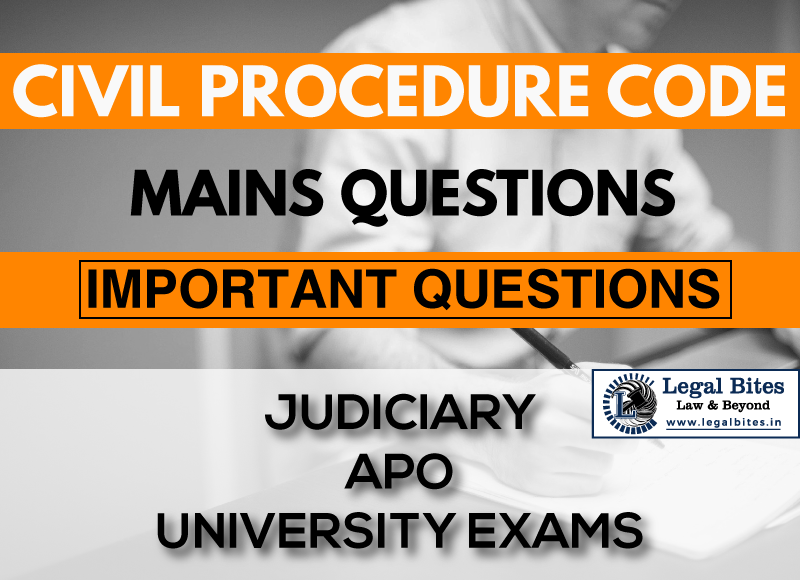Meaning and Procedure of Judgment and Decree under CPC, 1908
A very minute confusion always exists in the mind of people (including lawyers) with respect to the difference between judgment and decree. This article shall analyse the meaning and procedure of judgment and decree under the Code of Civil Procedure, 1908. It shall further explain the difference between judgment and decree. Introduction Section 2 (2) of the Code… Read More »
;
A very minute confusion always exists in the mind of people (including lawyers) with respect to the difference between judgment and decree. This article shall analyse the meaning and procedure of judgment and decree under the Code of Civil Procedure, 1908. It shall further explain the difference between judgment and decree. Introduction Section 2 (2) of the Code of Civil Procedure, 1908 ( hereinafter, ‘CPC’) defines the term decree and Section 2 (9) defines judgment. Accordingly,...
A very minute confusion always exists in the mind of people (including lawyers) with respect to the difference between judgment and decree. This article shall analyse the meaning and procedure of judgment and decree under the Code of Civil Procedure, 1908. It shall further explain the difference between judgment and decree.
Introduction
Section 2 (2) of the Code of Civil Procedure, 1908 ( hereinafter, ‘CPC’) defines the term decree and Section 2 (9) defines judgment. Accordingly, decree means a formal statement passed by the court by which the court declares that the case has been adjudicated and the expression conclusively determines the rights of the parties to the suit.
On the other hand, judgment means the statements made by the judge on the grounds of the decree or order. It means that judgment includes the grounds or reasons based on which the decree is passed. Hence, the decree is the verdict and judgment is a reason for the verdict.
Whenever a suit is instituted, the court can pass an order and/or a decree. An order is passed while the trial proceedings are still ongoing and decree is passed at the end of the trial because it conclusively determines the rights and liabilities of the parties. Thus, whenever, a court passes an order or a decree, it must mention the reasons for passing such order or decree. This reason is called judgment.
Judgment and Decree
According to Section 33 of the CPC, judgment shall be passed after the case has been heard by the court. This does not mean that the court must hear the entire case and only one judgment can be made, that is at the end of the trial. It means that the court must hear the parties on the point for which the judgment is being claimed by the plaintiff.
For instance, A has filed a suit against B for causing destruction of A’s property since B has started demolishing A’s property without lawful reasons. The suit may be for a permanent injunction but A can file an application for a temporary injunction as well while the case is proceeding.
Section 33 requires that the court shall hear the case of the parties with respect to a temporary injunction and then pass any judgment or order, etc. Section 33 also provides that the court shall pass judgment and “on such judgment, the decree shall follow”[1].
It means that after the case is heard and the court has made up its mind about the decision, first, judgment should be passed and then the decree should be passed. Basically, the decree should follow the judgment. It means that the court should give the reasons for making the decree and then pass the decree.
Manner in which Judgment is Pronounced
Order XX deals specifically with the procedure and manner in which judgment and decree are pronounced by the judge, the contents of the decree and time when they should be pronounced.
Rule 1 states that the court should pronounce the judgment after it has heard the entire case of the parties. The judgment should always be pronounced in an open court and at once. It means that the judgment should be pronounced in the presence of all the people present in the court along with the parties and their pleaders.
In certain exceptional circumstances, the court is entitled to hold in-camera proceedings where people not related to the case are not allowed to be present in the court. The judgment shall be pronounced at once. It connotes that the court should pronounce the entire judgment in one go and should not adjourn the matter in the middle of the judgment.
However, it is not a blanket provision that the judge needs to pronounce the judgment at once. Rule 1 also provides that if the judge believes that it is not practicable for the court to pronounce the judgment on the same day, the judge may fix a separate day when the judgment is to be pronounced.
In cases where the judgment is not pronounced on the same day when the case is finally heard, the court shall render a notice to the parties (if they are not present in the court) informing them of the date fixed for pronouncement of judgment. Such future date of pronouncing the judgment must be within 30 days from the conclusion of the trial and in any case, must not exceed sixty days.
The CPC does not provide anywhere for a mandatory written judgment. It means that judgment can be both oral and written and the court must read out and explain the judgment in whatever form it is. If the judgment is written, the judge need not read out the entire judgment but only the relevant parts and the final order that is passed in the case.
On the other hand, if the judgment is oral, the court can dictate the judgment and a stenographer (usually one expert in writing shorthand) can take down the judgment and a transcript be made ready and signed by the judge and certified copies of the transcript of the judgment shall be served to the parties to be collected from the court.
As aforementioned, a judgment, decree or order must be signed by the judge who pronounces the judgment. According to Rule 3, a judgment after being prepared (if it is in writing) should be dated and signed by the presiding officer of the court. The judgment is required to be signed when it is pronounced, i.e. soon after it is read out to the people in court. The judge cannot change anything mentioned in the judgment after it has been duly signed by him under the law.
However, Section 152 of the code makes an exception to Rule 3 and provides that if there is certain mathematical, calculative or any other form of clerical errors in the judgment which went past the scrutiny of the judges, then amendment can be done in the judgment at any time either by the court itself or on the filing of an application by any of the parties.
Considering the high mobility of judges in our nation, there can be a situation when a judge may hear entire case and fix a date for pronouncement of the judgment but before that day comes, he may retire or is transferred, etc. and is not able to pronounce the judgment. In such a case, Rule 2 comes to rescue because Rule 2 empowers a judge to pronounce a judgment written by his predecessor judge but not pronounced.
Separate Judgments for Separate Issues
Rule 5 of the XX Order requires that the court shall pronounce separate judgments for all the issues that have been framed. The requirement applies equally to decrees and orders as well. When the court has framed the requisite issues in a suit, it shall pass decree or order as the case may be according to such issues.
For every issue framed by the court, there must be certain decision and reasons for the decision to be recorded by the court. The court is entitled to pronounce one single judgment for more than one issue if the court finds that one decision or one finding shall be sufficient to dispose of the matter in the suit.
Procedure of Passing a Decree
According to Rule 6 of the Order XX of CPC, a decree should be in agreement with the judgment pronounced by the court. As has already been explained that under Section 33 of CPC, a decree shall follow the judgment. Hence, this rule states that a decree should be in consonance with the judgment. The judgment must explain the exact reasons for pronouncing such decree. If the decree and judgment have no link or relation, it may be ground of appeal.
For example, if the judgment explains why a decree of permanent injunction cannot be given, the decree should be that suit for a permanent injunction is dismissed. There must be a direct proportional relationship between the decree and judgment.
Under Rule 6, there are certain essential requirements that a decree shall contain. These are:
- Details of the parties including their names and registered addresses
- The Suit number as allocated while filing of the suit
- The respective claims of the parties involved
- The relief that is granted by the court and/or any other finding that the court considers necessary to pronounce.
- The expense borne by the plaintiff towards the costs of filing the suit and litigation.
- Date on which the decree is pronounced and the signatures of the judge who pronounced such decree.
- The name of the party who shall bear the litigation cost borne by the plaintiff at the initiation of trial. If the litigation cost is to be paid in part by both the parties, the decree must contain the exact part that each of the parties have to pay.
- If the party paying cost is entitled to receive certain sum from the opposite party, the court may allow the cost to be set off from the payable amount and mention the same in the decree.
Manner in which Decree is Pronounced
Rule 6A of the Code requires that a decree should be pronounced as soon as it is possible and practicable for the court to pass a decree. The provision states that the decree should be passed within 15 days from the date on which the judgment is pronounced by the court. When the court drafts the decree, it needs to be collected from the registrar office within the court, by the parties who is/are in need of the decree.
Service of a copy of the judgment might take some time and filing of appeal before a higher court depends on such decree. Hence, Sub-rule 2 of Rule 6 enables a party to the suit willing to appeal the higher court even without the copy of the decree and submit the decree when it issued by the trial court.
It is not always required that the presiding officer of the court who pronounced the decree shall sign it as well. If the judge pronouncing the decree resigns or his post terminates before the decree is pronounced, his successor judge can sign the decree.
References
- Dinshaw F. Mulla, The Key to Indian Practice: A Summary Of The Code Of Civil Procedure, 11th 2015.
- C. Sarkar, Sarkar Code of Civil Procedure, (2017).
- K. Takwani, Civil Procedure, 8th ed. 2018.
[1] Section 33, Code of Civil Procedure, 1908.


